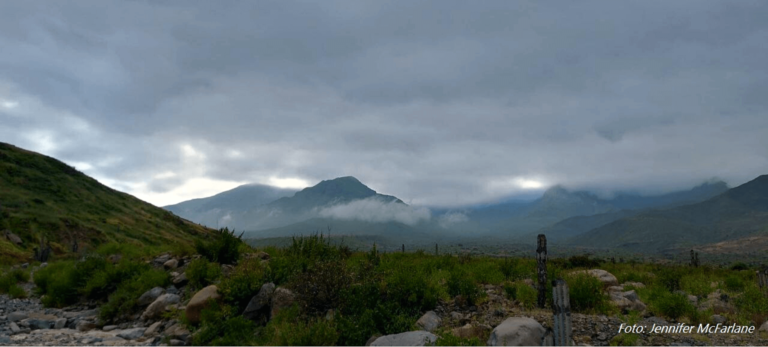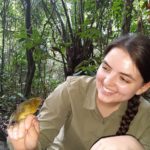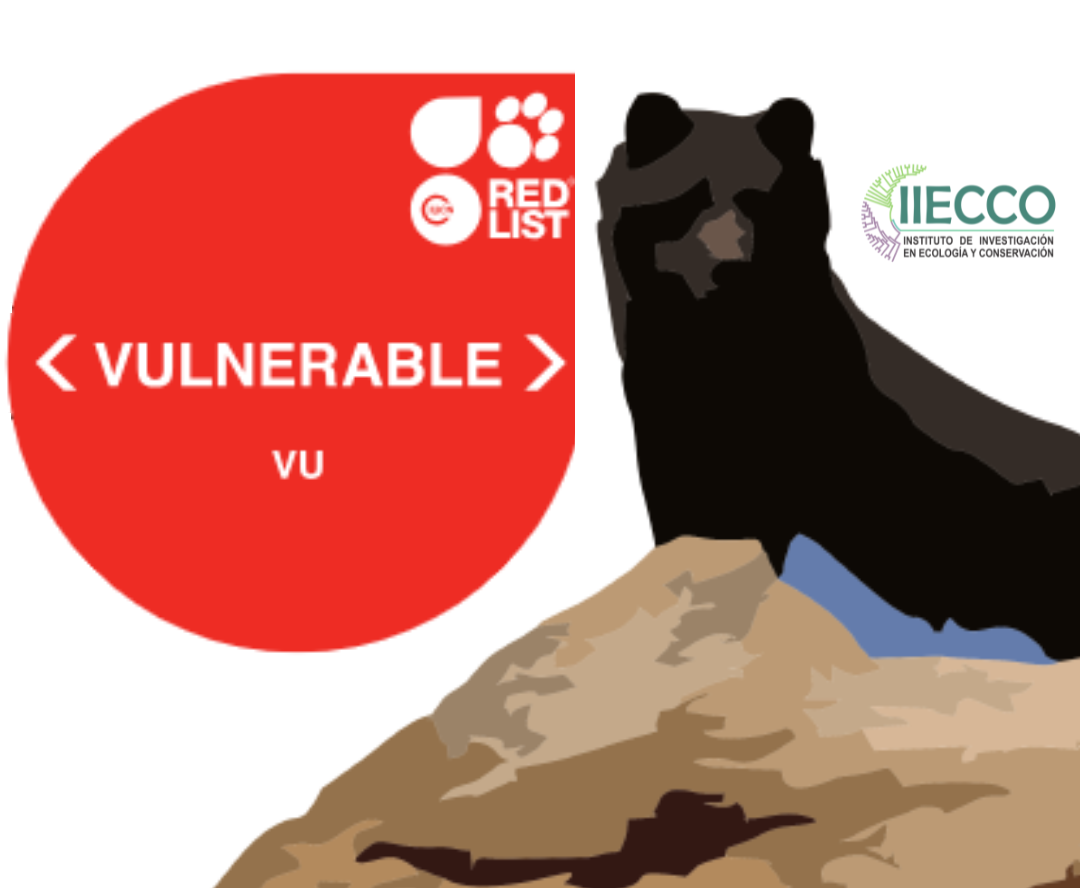Proyecto: Estado de conservación del oso de anteojos en la Reserva Nacional de Calipuy
Andean Bear Project: Conservation status of the spectacled bear in the Calipuy National Reserve
The Andean bear is the only bear species residing in South America and is endemic to the tropical Andes Mountain range (García-Rangel, 2012; Emmons & Feer, 1997). Ranging 4,600 km from Venezuela, through to Columbia, Ecuador, Peru, and Bolivia, it inhabits a wide range of habitats including cloud forest, high-altitude grasslands, dry forests, shrublands, and deserts with an altitudinal range of 200 to 4750 metres (García-Rangel, 2012; Peyton, 1999). Like other bear species such as brown and black bears, the Andean bear is omnivorous, consuming mostly fruit and vegetation and occasionally meat to supplement their diet (Hernani-Lineros, Garcia, & Pacheco 2020). Andean bears play an important role in their ecosystem. Due to their large home ranges, they are considered an umbrella species, as their ranges cover a wide variety of habitats and high numbers of endemic flora and fauna (Peyton, 1999; Mares, 1992). In addition, the Andean bear is a key seed disperser which aids forest and plant regeneration, helping to maintain ecosystem resilience (Figueroa et al., 2013; Rivadeneira-Canedo, 2008). Conserving the species would therefore simultaneously conserve other species and their habitats.
The species is classified as “vulnerable” by The International Union for Conservation of Nature (IUCN) due to habitat loss and fragmentation from increasing human development and climate change (Velez- Liendo & García-Rangel, 2017). Andean bears occur at low densities and require large home ranges covering large well-connected habitat in order to persist in the landscape (Yerena, 1998), making them particularly vulnerable to habitat loss (Peyton, 1999). The main drivers of this loss include the expansion of the agricultural frontier, poor agricultural practices and reforms, mining, land conversion for coca crops, the drug trade, and biodiversity shift caused by climate change (García-Rangel, 2012; Peyton, 1999; Tover et al., 2013).
Despite these threats and conservation importance, research knowledge of the bear’s ecology is still in its early stages with the need to address habitat use, responses to landscape features, effective habitat availability, and robust population size estimates to assist in conservation efforts (García-Rangel, 2012). The resource use of Andean bears is not fully understood (García-Rangel, 2012; Morrell et al., 2021) and has been little studied in coastal desert habitat (Figueroa, 2012). The more limited water and food resources in dry shrublands and coastal deserts (compared to cloud forests) may result in a strikingly different use of habitat. This means that conclusions about species management derived from well-studied cloud forest or grassland populations may not be appropriate for coastal populations.
Peru hosts about a third of the species range in the Andes where it occupies the largest variety of habitat types and elevations found in any other country (Peyton, 1999). The species is mostly associated with cloud forests and high-altitude grasslands however dry montane forests and desert represent a unique ecosystem occupied by the bears yet little is known about these populations and their habitat use (Morrell et al., 2021). This habitat was subsequently included into a conservation unit in Northwest Peru covering > 33,0000 km2 (Wallace et al., 2014). A recent study in the dry forests of the Lambayeque region (north of La Libertad region) revealed large areas of high-quality habitat are available outside of the recognised IUCN species range and their bear populations still remain unmapped (Morrell et al., 2021).

Figura 1. Reserva Nacional de Calipuy, La Libertad, Perú.
Further south to the Lambayeque study lies Calipuy National Park. Mostly consisting of dry shrubland and desert areas, it has consistent reports by locals and park rangers of bears occupying large areas of the site all year round. For this reason, it potentially represents the most southern bear population of the western Andes and is thought to be one of the last links to the central Andean bear populations. These observations have gone largely unreported and as a consequence the bear population has remained overlooked and unrecognised. The few reports published are mostly within the ‘grey literature’ and are sporadic, outdated, and have only been obtained through tracks and sign or interviews (Peyton, 1980, Figueroa & Stucchi, 2009, Figueroa, 2012, Figueroa, 2015). There are more modern approaches available such as using camera traps, and collaborating with park rangers to aid research and monitoring efforts.
Camera traps are able to record cryptic species such as the Andean bear directly. They use passive infrared sensors that detect movement and temperature differences which remotely triggers the camera to take photos. They are a non-invasive method that offers insight into the activities of otherwise elusive animals both during the day and the night over long periods of time.

This project aims to assess the distribution and habitat use of Andean bears using camera traps in Calipuy National Reserve through the following objectives:
- Estimate the occupancy (presence/absence) of the Andean bear along environmental and anthropogenic gradients (e.g., habitat type, elevation, vegetation density, distance to village, distance to water, season).
- Describe bear activity patterns along environmental and anthropogenic gradients and between seasons using camera trapping data.
- Train rangers and volunteers in camera trapping methodology through workshops and fieldwork sessions.
These objectives will contribute directly to the Peruvian National Conservation plan for Andean Bears (SERFOR, 2016 – 2026), specifically to the knowledge of distribution of populations, identifying human conflict, training local authorities, and providing information towards decision-making and management interventions. Regionally, the Andean bear is a highly representative species therefore results will contribute to biodiversity conservation initiatives carried out by Peruvian government agencies. Locally, the Andean bear is a research priority for Calipuy Reserve which was created for the purpose of stimulating scientific research in the under-studied La Libertad region of Peru. The results of the project will then be used in management and monitoring plans for the reserve, as well as promote further research.
To aid in this research effort, IIECCO is collaborating with Calipuy National Reserve (SERNANP), Bears in Mind, Nature Spy, and Idea Wild.











Jennifer McFarlane
Coordinadora del Proyecto
REFERENCIAS
Emmons, L., & Feer, F. (1997). Neotropical rainforest mammals: a field guide (No. Sirsi) i9780226207193).
Figueroa J. 2012. The Cacti in the Diet of the Andean Bear (Tremarctos ornatus) in Peru. International Bear News 21 (4): 32-34.
Figueroa J. 2015. Interacciones humano-oso andino Tremarctos ornatus en el Perú: consumo de cultivos y depredación de ganado. Therya 6 (1): 251-278.
Figueroa J. & M. Stucchi. 2009. El Oso Andino: alcances sobre su historia natural. Asociación para la investigación y conservación de la biodiversidad-AICB. Primera Edición, Lima, Perú. 105 pp.
Figueroa, J.; Stucchi, M.; Rojas-VeraPinto, R. El Oso Andino (Tremarctos ornatus) Como Especie Clave Para la Conservación del Bosque Seco del Marañón (Cajamarca–Amazonas, Perú); Cooperación Técnica Alemana (GIZ): Lima, Peru; Asociación para la Investigación y Conservación de la Biodiversidad (AICB): Lima, Perú, 2013.
García‐Rangel, S. (2012). Andean bear Tremarctos ornatus natural history and conservation. Mammal review, 42(2), 85-119.
Hernani-Lineros, L., Garcia, E., & Pacheco, L. F. (2020). Andean bear diet near to and far from a road. Ursus, 2020(31e7), 1-7.
Morrell, N., Appleton, R. D., & Arcese, P. (2021). Roads, forest cover, and topography as factors affecting the occurrence of large carnivores: The case of the Andean bear (Tremarctos ornatus). Global Ecology and Conservation, 26, e01473.
Peyton B. 1980. Ecology, Distribution, and food habitat of Spectacled Bears, Tremarctos ornatus, in Peru. Journal of Mammalogy 61 (4): 639-652.
Peyton, B. (1999). Spectacled bear conservation action plan. Bears: status survey and conservation action plan, 157-164.
Rivadeneira-Canedo, C. (2008). Study of the Andean bear (Tremarctos ornatus) as a legitimate seed disperser and elements of its diet in the region of Apolobamba-Bolivia. Ecología en Bolivia, 43(1), 29-40.
Servicio Nacional Forestal y de Fauna Silvestre SERFOR. (2016). Plan Nacional de Conservación del Oso Andino (Tremarctos ornatus) en el Perú. Periodo 2016 – 2026. Lima, Perú: SERFOR.
Tovar, C., Arnillas, C. A., Cuesta, F., & Buytaert, W. (2013). Diverging responses of tropical Andean biomes under future climate conditions. PloS one, 8(5), e63634.
Velez-Liendo, X. & García-Rangel, S. (2017). Tremarctos ornatus (errata version published in 2018). The IUCN Red List of Threatened Species 2017: e.T22066A123792952. https://dx.doi.org/10.2305/IUCN.UK.2017- 3.RLTS.T22066A45034047.en. Accessed on 17 January 2022.
Wallace, R. B. (Ed.). (2014). Unidades de conservación prioritarias del oso andino en Bolivia y en Perú. Wildlife Conservation Society.
Yerena, E. (1998). Protected areas for the Andean bear in South America. Ursus, 101- 106

